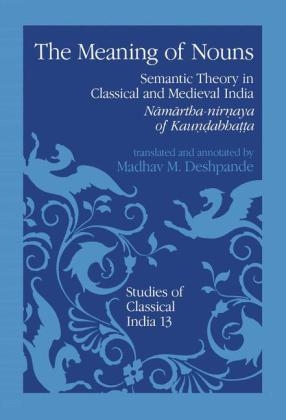
The Meaning of Nouns
Semantic Theory in Classical and Medieval India. Namartha-Nirnaya of Kaundabhatta
Seiten
1992
|
1992 ed.
Kluwer Academic Publishers (Verlag)
978-0-7923-1847-7 (ISBN)
Kluwer Academic Publishers (Verlag)
978-0-7923-1847-7 (ISBN)
Takes account of the philosophical debate which occurred in classical and medieval India among the philosophers and grammarians from about 500 BC to the 17th century AD. This book discusses ontological, epistemological, and exegetical issues concerning the notion of meaning as it relates to the various components of language.
Kaun&ddotu;abhatta's Vaiyakarana-bhusana is a massive work on semantic theory written in India in the 17th century. Kaun&ddotu;abhatta belonged to the tradition of Sanskrit grammar and in this work he consolidated the philosophy of language developed in the Paninian tradition of Sanskrit grammar. Kaun&ddotu;abhatta's work takes account of the philosophical debate which occurred in classical and medieval India among the philosophers and grammarians from about 500 B.C. to the 17th century A.D. Kaun&ddotu;abhatta's work primarily represents this debate between the traditions of Sanskrit grammar, Mi&mdotu;amsa, and Nyaya-Vaisesika. It discusses ontological, epistemological, and exegetical issues concerning the notion of meaning as it relates to the various components of language. The present book is a heavily annotated translation of the Namartha-nirnaya section of Kaun&ddotu;abhatta's Vaiyakarana-bhusana, with an extensive introduction.
While there are several books that discuss Indian semantic theories in general terms, this book belongs to a small class of intensive, focused studies of densely written philosophical texts which examines each argument in its historical and philosophical context. It is of interest to all students of philosophy of language in general, and to students of Indian philosophy in particular.
Kaun&ddotu;abhatta's Vaiyakarana-bhusana is a massive work on semantic theory written in India in the 17th century. Kaun&ddotu;abhatta belonged to the tradition of Sanskrit grammar and in this work he consolidated the philosophy of language developed in the Paninian tradition of Sanskrit grammar. Kaun&ddotu;abhatta's work takes account of the philosophical debate which occurred in classical and medieval India among the philosophers and grammarians from about 500 B.C. to the 17th century A.D. Kaun&ddotu;abhatta's work primarily represents this debate between the traditions of Sanskrit grammar, Mi&mdotu;amsa, and Nyaya-Vaisesika. It discusses ontological, epistemological, and exegetical issues concerning the notion of meaning as it relates to the various components of language. The present book is a heavily annotated translation of the Namartha-nirnaya section of Kaun&ddotu;abhatta's Vaiyakarana-bhusana, with an extensive introduction.
While there are several books that discuss Indian semantic theories in general terms, this book belongs to a small class of intensive, focused studies of densely written philosophical texts which examines each argument in its historical and philosophical context. It is of interest to all students of philosophy of language in general, and to students of Indian philosophy in particular.
Approximate Chronology of Indian Philosophers. Preface. Introduction. A: Artha 'Meaning'. B: Logical Basis of Semantic Analysis. C: What is a Naman 'Noun, Nominal Stem'? D: Ontology of Possible Nominal Meanings. E: Functional Apparatus of a Semantic Theory. F: Sabda itself as Artha: Use versus Mention. G: Bhattoji Diksita and Kaun&ddotu;abhatt. H: Kaun&ddotu;abhatta's Namartha-nirnaya. I: Conclusion. Namartha-nirnaya with Translation and Annotation. Bibliography. Index.
| Reihe/Serie | Studies of Classical India ; v. 13 |
|---|---|
| Übersetzer | Madhav M. Deshpande |
| Zusatzinfo | black & white illustrations |
| Sprache | englisch |
| Maße | 156 x 234 mm |
| Gewicht | 615 g |
| Einbandart | gebunden |
| Themenwelt | Geisteswissenschaften ► Philosophie ► Östliche Philosophie |
| ISBN-10 | 0-7923-1847-1 / 0792318471 |
| ISBN-13 | 978-0-7923-1847-7 / 9780792318477 |
| Zustand | Neuware |
| Informationen gemäß Produktsicherheitsverordnung (GPSR) | |
| Haben Sie eine Frage zum Produkt? |
Mehr entdecken
aus dem Bereich
aus dem Bereich


